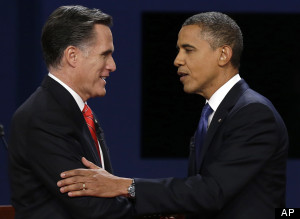You’ll be hearing from people far more qualified (and better paid) than I telling you who “won” and who “lost” last night’s second Presidential debate. But from the perspective of the critical thinking concepts and tools discussed on this blog and on the podcast over the last few months, some takeaways from last night’s event include:
Expectations Management
The reasons expectations need to be managed is that, unless someone actively intervenes, they tend to gravitate to different places on their own. For instance, before the first debate, expectations of Obama were quite high (because of his reputation as a skilled orator) while those of Romney were low (due to his lack of such a reputation).
But the dynamic of the first debate (during which Obama did poorly) lowered expectations for him while raising them for his rival. Which meant that Obama merely had to do better than last time (which he did) to exceed expectations while Romney had to do at least as well as last time (which he didn’t) just to meet them.
And while there will be a lot of talk regarding who presented the more convincing case, the game of expectations is driven primarily by that fast-processing part of our brain which prefers a good story (“The Empty Chair,” “The Comeback Kid”) to more complex reality.
Audience
And speaking of reality, keep in mind that the primary audience for last night’s debate was the same as ever: TV viewers and the media. Which meant that the people in the room asking questions in that Town Hall style forum were pretty much just props whose questions provided a category (jobs, women, immigration, Libya) into which the candidates could fit stock responses prepared in advance.
Now some politicians can pull off the trick of looking like they’re responding directly to people in the room while actually delivering a prepared text. But neither Obama or Romney really possess this skill (which provides one of the mechanics behind why, as Jay Heinrichs pointed out during this week’s podcast, neither candidate is considered very good in an informal setting).
Format
Unlike the first debate, the looser format of last night’s contest (which asked each candidate to give a two minute response to a question from the audience, followed by a two minute follow up) allowed the candidates to fall back to what has become a default approach to national debates which involves each person sticking to prepared talking points while avoiding direct engagement with one another.
You could see this play out in both words and body language, especially during instances where Romney tried to put his rival on the spot by asking a direct (often loaded) question while starting him in the eye, which his opponent parried by simply refusing to return the gaze (or even look in Romney’s direction).
The prepping and practice and coaching and polished technique that fuels these types of performances does a good job at helping the candidates avoided what they dread most: an unexpected moment. But they also drain debate of drama and, more importantly, prevent the type of genuine argumentation you would get from a situation involving two people actually talking to one another.
This is why, as Kevin deLaplante pointed out two weeks ago, you can’t really apply the same rules you would use to analyze argumentative dialog (picking apart the logic, finding the fallacies, Canons of Rhetoric, etc.) when trying to understand the type of performance art national debates have evolved (or devolved) into.
But other critical thinking tools (notably Aristotle’s Modes of Persuasion) are still relevant, which is why most of the analysis, interpretation and spin you will be hearing over the next several days basically boils down to the question of who left the stage seeming more appealing and trustworthy.
These characteristics currently travel under more modern-sounding names (such as “likability” and “seeming Presidential”), possibly to mask the fact that this Presidential race, like most Presidential races, boils down to a contest of who winds up netting the most ethos (either by building up his own, or burning the other guy’s stockpile of the stuff).




